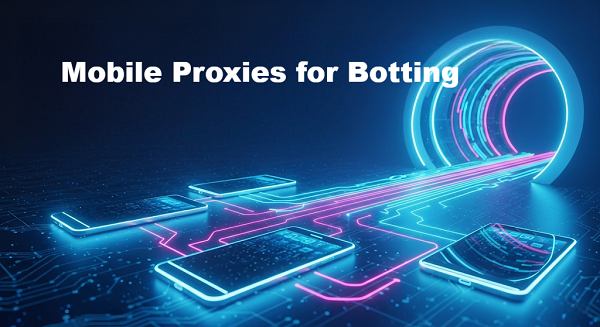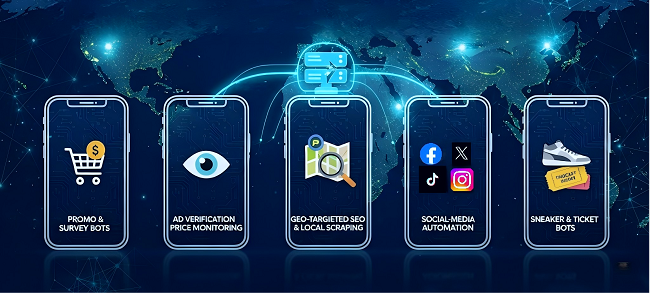HTML Parsing in Python Guide: From Basics to Advanced
Explore how to parse HTML with Python: concepts, tool choices, ethics, runnable examples, dynamic pages, and scaling tips.
Dec 15, 2025
Master carrier-grade mobile proxies for sneaker copping, social automation, geo-scraping—step-by-step setup, pros & cons, and scaling tips.
For automated purchasing, sensitive web scraping, and social-media management, standard proxies often fall short. Today’s anti-bot defenses flag datacenter IPs in seconds, and even residential pools can be tracked. Mobile proxies—carrier-grade IPs sourced from real 3G/4G/5G devices—offer the stealth and rotation you need to outsmart modern protections. You’ll also discover tasks (e.g., app-only in-store pickups) that residential proxies simply cannot handle.

Beginners
Tired of endless CAPTCHA loops? We start from zero—no prior proxy chops needed.
Need clear, non-jargon explanations.
Intermediate Users
Frustrated when residential pools trigger extra verifications? Learn to cut ban rates by 50%+.
Seeking better geo-targeting for local scraping and automations.
Professionals & Enterprises
Managing hundreds of bot accounts? Nail consistency at enterprise scale.
Scaling geo-targeted scraping and social automation across regions.
A mobile proxy is a type of proxy server using IPs assigned by mobile carriers (e.g., AT&T, Vodafone) and routing through a pool of real devices, such as smartphones. Unlike residential proxies (tied to home internet providers) or datacenter proxies (from server farms), mobile proxies use dynamic IPs from cellular networks, making them incredibly hard to detect.
Your bot’s requests pass through a mobile device connected to a cellular network, which forwards them to the target site using its mobile IP. The site sees a legitimate mobile user, reducing suspicion. Here’s a simple breakdown:
Bot → Mobile Proxy (Device) → Target Website
Think of this like your phone’s IP changing as you move between Wi-Fi and cell towers. Mobile IPs rotate automatically as devices switch connections, keeping your bot’s identity fresh without any extra effort.
| Feature | Mobile | Residential | Datacenter |
| Trust Score | ★★★★★ | ★★★★☆ | ★★☆☆☆ |
| Rotation | Carrier-driven per minute | Pool-based via API | Manual/Schedule |
| Latency | Moderate (40–100 ms) | Variable (30–200 ms) | Low (10–50 ms) |
| Cost | High ($1–$3 /port/day) | Medium ($0.10–$1 /GB) | Low ($0.01–$0.05 /GB) |
| Detection Risk | Minimal | Low–Medium | High |
| Geo-Targeting | City/ZIP | Country | Country |
What mobile proxies give you that no other proxy can:
HTTP headers, user-agent strings, TCP window sizes mirror real smartphones.
IPs refresh every few minutes thanks to carrier churn—no manual setup required.
High carrier reputation; anti-bot systems default to “human.”
Drill down to city or ZIP code for hyper-local tasks residential can’t reach.
Device-locked promos often reject residential IPs.
Steps:
Use Selenium to automate survey submissions.
Rotate mobile proxy per form submission.
Clear cookies/user data.
Randomize form-fill delays (3–7 s).
Mobile-app ad placements unseen by residential.
Steps:
List test URLs per ad placement.
Loop through proxies by region; log impressions & redirects.
Alert on missing ads/unexpected redirects.
Mobile SERPs often differ from desktop/residential.
Puppeteer Snippet:
js
const browser = await puppeteer.launch();
const page = await browser.newPage();
await page.authenticate({username:'USER', password:'PASS'});
await page.goto('https://www.google.com', {timeout:60000});
Steps:
Acquire mobile proxies in target cities.
Set --proxy-server=http://USER:PASS@host:port per page.
Compare mobile vs. desktop SERPs to spot discrepancies.
Many platforms favor mobile UA and IP combos.
Steps:
Assign each account a unique mobile port.
Schedule posts in off-peak windows.
Rotate user-agents (Android/iOS) between sessions.
Nike SNKRS and Ticketmaster mobile-app checks block non-mobile IPs.
Steps:
Purchase 20-50 ports in your target region.
Configure bot (e.g. AIO Bot) per port/account.
Simulate human delays (2–5 s) per checkout step.

| Challenge | Impact | Solution |
| Higher Costs | 2–3× pricier than residential | Reserve mobile for high-value tasks; blend with residential. Example: For a sneaker drop, use mobile proxies for checkout and residential proxies for stock checks to balance cost and performance. |
| Speed Variability | 20–50% slower at peak (6–9 pm) | Test pools at different times; choose low-latency providers like GoProxy; run critical tasks off-peak. |
| Setup Complexity | Newbies may struggle | Follow Quickstart guide below; leverage provider docs & support. |
Pro Tip: Always test a small pool (5–10 ports) first to validate performance before scaling.
Reliability: Consistent uptime & low error rates.
IP Pool Size: Larger pools reduce reuse and detection.
Speed: Critical for time-sensitive tasks.
Support: 24/7 chat or ticket response.
Pricing: Transparent port- or bandwidth-based plans.
Port-Based: Flat daily fee per proxy endpoint.
Bandwidth-Based: $ per GB consumed (rare for mobile).
Session-Based: Pay per IP switch or session.
Terms of Service: Many platforms (e.g., Ticketmaster) prohibit automated access—review their TOS.
Local Regulations: GDPR, CCPA, and other privacy laws may restrict data collection—consult legal experts.
Ethical Use: Throttle request rates, respect robots.txt, and avoid overloading target servers.
Bot-Friendly APIs: Consider using official APIs where available (e.g., Twitter’s developer API) to stay compliant.
Sign up with a reliable mobile proxy provider(e.g., GoProxy—optimized for APAC latency).
Select a mobile proxy plan, you’ll receive something like 192.168.1.1:8080:user:pass.
Breakdown: 192.168.1.1:8080 = IP and port; user:pass = credentials.
Configure tools like SwitchyOmega with your proxy; Visit https://api.ipify.org to confirm IP.
bash
curl -x http://USER:PASS@host:port https://api.ipify.org
SDK/Library Integration: Use provider’s Python/Node module for session handling.
Python SDK Example
python
import requests
proxies = {"http": "http://user:[email protected]:8080"}
response = requests.get("https://api.ipify.org", proxies=proxies)
print(response.text)
Scaling: Use a proxy manager to automate port rotation and health checks.
If login-heavy tasks → Sticky (5–15 min)
If data scraping → Per-request rotation
If mixed tasks → Hybrid (sticky for auth, rotating for fetch)
Ban rate < 2% per 100 requests
Latency < 150 ms average
Error rate < 1% (403/429)
| Error Code | Cause | Action |
| 403 | IP flagged | Rotate to backup port |
| 407 | Authentication issue | Verify username/password |
| 502/503 | Too many parallel sessions | Reduce concurrency or switch IP |
| Timeout | Network congestion | Test at off-peak; swap proxy |
Common Mistake: Reusing ports across accounts without clearing cookies—sites can link them.
You’re now ready to leverage mobile proxies for botting success—whether it’s Promo Bots, Ad Verification, Geo-SEO, Social Automation, or Sneaker Copping.
Next Steps:
Check out our Guide to Proxies for Bots for more foundational tips.
Start with 5–10 ports per 100 requests/hour; adjust linearly.
Yes—use mobile for high-value tasks and residential for bulk scraping to optimize cost.
The tool is legal; your usage must comply with local laws and site TOS.
Their genuine device headers make them far harder to fingerprint than residential.
Absolutely—mobile IPs align with Instagram’s mobile-first traffic, reducing bans.
< Previous
Next >
 Cancel anytime
Cancel anytime No credit card required
No credit card required